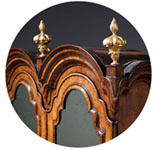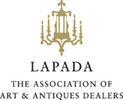18th Century George III Mahogany Quarter Striking Automation Bracket Clock by Stephen Rimbault
Sold
Request Information
Follow Us
18th Century George III Mahogany Quarter Striking Automation Bracket Clock by Stephen Rimbault
By Stephen Rimbault
The impressive mahogany case has a bell top and is surmounted by four pineapple finials on the corners and an additional finial to the centre. There are carrying handles to each side as well as circular silk-backed pierced brass sound frets. The case is glazed on all sides so that the complex movement is almost entirely visible. It rests on four brass ogee bracket feet and brass mouldings to both the top and base.
The extremely unusual partly painted shaped brass dial has a silvered Roman chapter ring with a recessed signature plaque, Stpn Rimbault London, and a date aperture in the matted centre. In the corners are fine pierced gilt brass spandrels. The time is indicated by a pair of very fine pierced blued-steel hands on the Roman chapter ring with Arabic five-minute and minute divisions.
The special, extremely rare and charming feature of the clock, is that above the dial there is a painted automaton depicting four eighteenth-century dress musicians, one playing the harpsichord, two other string instruments and a conductor. The hand of the harpsichord player, the bows of the string instruments players and the conductor’s baton are constantly moving with the going train. Fabulous!
The triple gut-fusee spring-driven eight-day movement has a going train with its original verge escapement and short pendulum with knife-edge suspension. The quarters are chimed on a nest of eight bells with eight hammers, on the hour followed by the hour on an additional bell. In addition, the striking can be repeated at will by pulling a cord to the side. The backplate is elaborately engraved around the maker’s signature Stpn Rimbault London.
Note on the maker
As his name suggests Stephen Rimbault was of Huguenot descent. He specialised in musical and/or automaton clocks in the second and third quarters of the eighteenth century. There is a most impressive clock by his hand in the Ashmolean Museum in Oxford. His brother Paul was also a clockmaker, of whom we also have a clock in our collection, albeit of a much more moderate style.
Condition
Good. Wear consistent with age and use.
Dimensions
Height: 21.66 in. (55 cm)
Width: 11.42 in. (29 cm)
Depth: 7.68 in. (19.5 cm)
Literature
Brian Loomes, Watchmakers and Clockmakers of the World, London, 2006, p. 656.
PREVIOUSLY SOLD
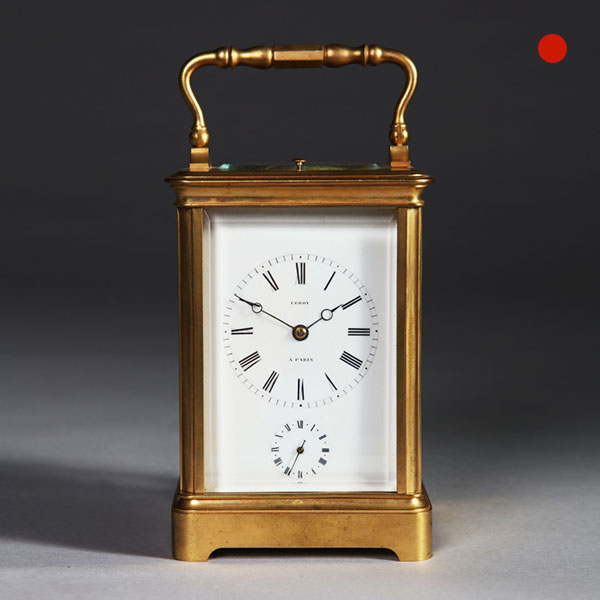
19th-Century Quarter-striking Carriage Clock by Leroy, Paris
The gilt-brass, so-called corniche case has bevelled glass panels on all sides so that the movement is entirely visible. It is surmounted by a shaped carrying handle. The white enamel dial has a Roman chapter ring, with Arabic five-minute and minute divisions.
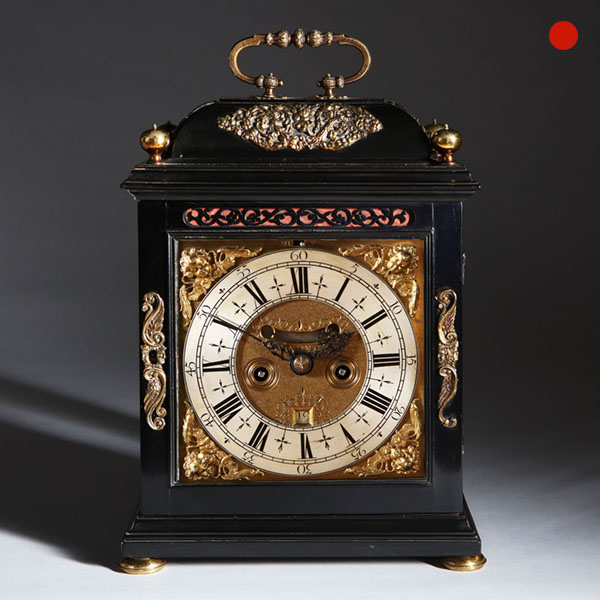
William and Mary Ebony Veneered Bracket Clock by Johnathan Lowndes
The ebony-veneered case has a so-called domed top, a design which became popular in the Charles II period (from 1675 onwards). The case is adorned with repousse brass ornaments and rests on gilt-brass bun feet. It is surmounted by a brass carrying handle of typical shape.
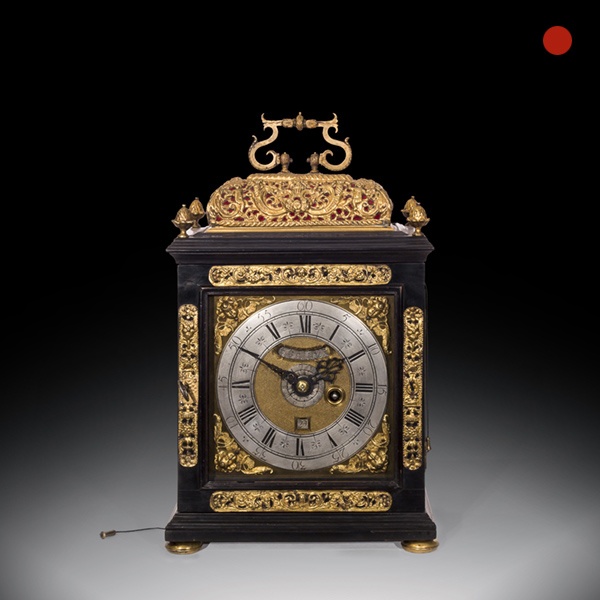
17th-Century Ebony Veneered Table Clock with Alarm and Pull Quarter Repeat
A magnificent sprung driven table clock by respected London maker George Etherington. The late 17th century, ebony- veneered table clock with alarm and pull quarter repeat on two bells, signed on the chapter ring Etherington London, and on the backplate Geo Etherington LONDON, c. 1695-1700.
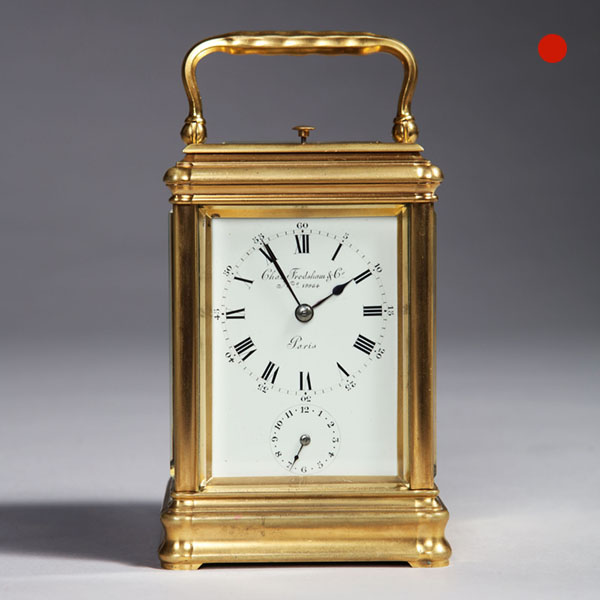
19th-Century Carriage Clock signed Charles Frodsham, London
The so-called gorge case has its original gilding. It has bevelled glass panels on all sides so that the movement is entirely visible and is surmounted by a shaped carrying handle. The white enamel dial has a Roman chapter ring, with Arabic five-minute and minute divisions.

19th-Century Quarter-striking Carriage Clock by Leroy, Paris
The gilt-brass, so-called corniche case has bevelled glass panels on all sides so that the movement is entirely visible. It is surmounted by a shaped carrying handle. The white enamel dial has a Roman chapter ring, with Arabic five-minute and minute divisions.

William and Mary Ebony Veneered Bracket Clock by Johnathan Lowndes
The ebony-veneered case has a so-called domed top, a design which became popular in the Charles II period (from 1675 onwards). The case is adorned with repousse brass ornaments and rests on gilt-brass bun feet. It is surmounted by a brass carrying handle of typical shape.

17th-Century Ebony Veneered Table Clock with Alarm and Pull Quarter Repeat
A magnificent sprung driven table clock by respected London maker George Etherington. The late 17th century, ebony- veneered table clock with alarm and pull quarter repeat on two bells, signed on the chapter ring Etherington London, and on the backplate Geo Etherington LONDON, c. 1695-1700.

19th-Century Carriage Clock signed Charles Frodsham, London
The so-called gorge case has its original gilding. It has bevelled glass panels on all sides so that the movement is entirely visible and is surmounted by a shaped carrying handle. The white enamel dial has a Roman chapter ring, with Arabic five-minute and minute divisions.
YOU MAY ALSO LIKE
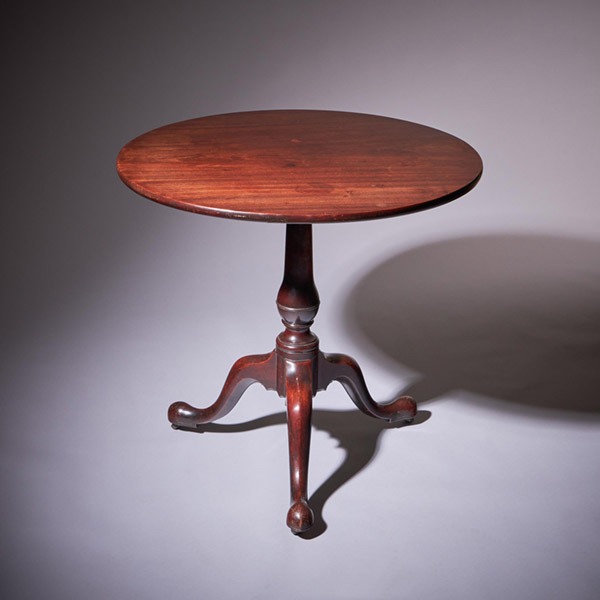
18th Century George III Mahogany Tripod Table, Circa 1770
18th Century George III Mahogany Tripod Table, Circa 1770 £2,200Follow Us18th Century George III...
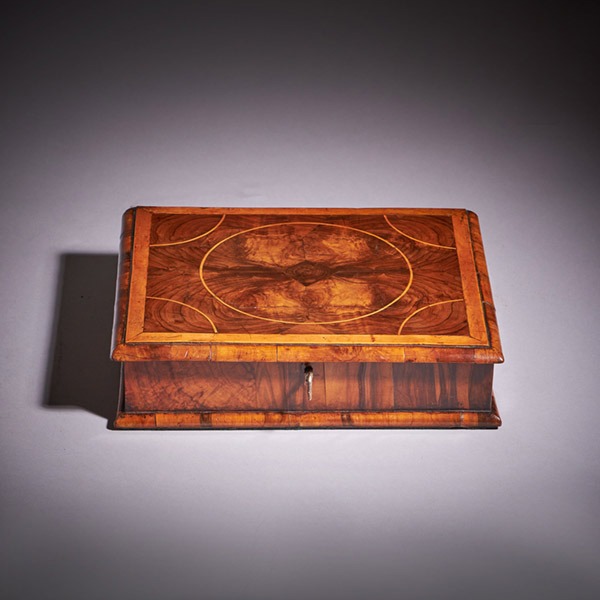
Fine William and Mary 17th Century Olive Oyster Lace Box
Fine William and Mary 17th Century Olive Oyster Lace Box £2,600Follow UsFine William and Mary 17th...
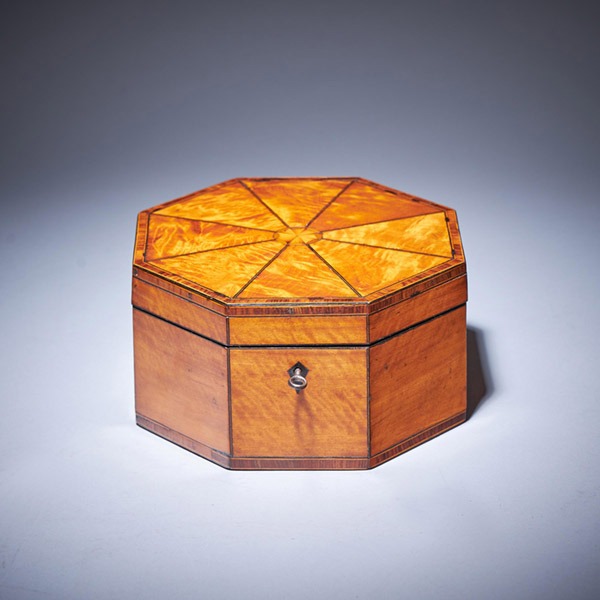
A Fine and Rare George III Octagonal Figured Satinwood Box, C.1790
A Fine and Rare George III Octagonal Figured Satinwood Box, C.1790 £2,200Follow UsA Fine and Rare...
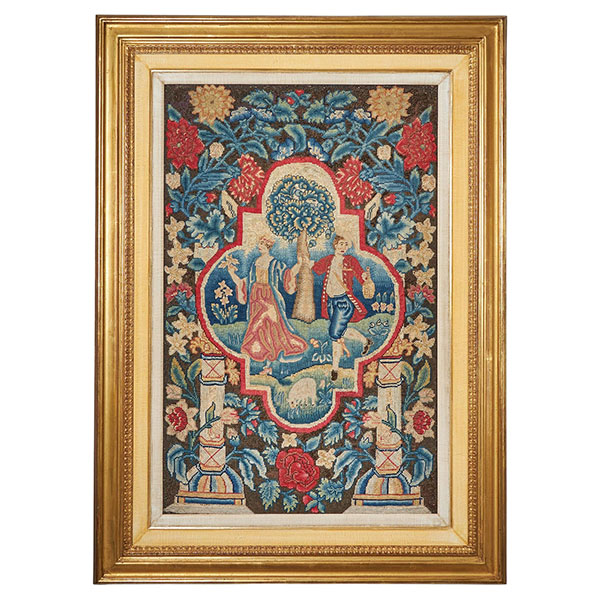
A Rare and Vibrant Framed 18th Century George II Needlework Picture, Circa 1730
A Rare and Vibrant Framed 18th Century George II Needlework Picture, Circa 1730 £16,000Follow UsA Rare and Vibrant Framed 18th Century George II Needlework Picture, Circa 1730 A rare and vibrant early 18th century George II pictorial...
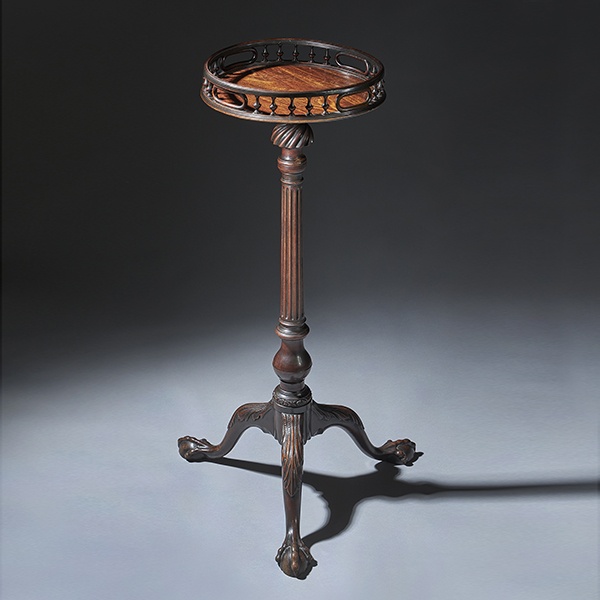
A Fine George II 18Th Century Chippendale Period Carved Mahogany Torchiere. Circa 1755-1765, England
A FINE GEORGE II 18TH CENTURY CHIPPENDALE PERIOD CARVED MAHOGANY TORCHIERE Circa 1755-1765, England £25,000Follow UsA FINE GEORGE II 18TH CENTURY CHIPPENDALE PERIOD CARVED MAHOGANY TORCHIERE, Circa 1755-1765, England An exquisitely fine and...
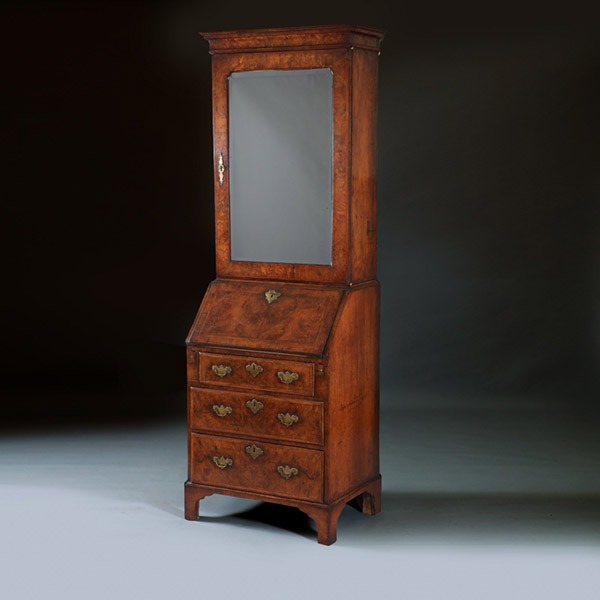
A Fine Early 18th Century George I Burr Walnut Bureau Bookcase, Circa 1715
A Fine Early 18th Century George I Burr Walnut Bureau Bookcase, Circa 1715 £11,500Follow UsA Fine...

18th Century George III Mahogany Tripod Table, Circa 1770
18th Century George III Mahogany Tripod Table, Circa 1770 £2,200Follow Us18th Century George III...

Fine William and Mary 17th Century Olive Oyster Lace Box
Fine William and Mary 17th Century Olive Oyster Lace Box £2,600Follow UsFine William and Mary 17th...

A Fine and Rare George III Octagonal Figured Satinwood Box, C.1790
A Fine and Rare George III Octagonal Figured Satinwood Box, C.1790 £2,200Follow UsA Fine and Rare...

A Rare and Vibrant Framed 18th Century George II Needlework Picture, Circa 1730
A Rare and Vibrant Framed 18th Century George II Needlework Picture, Circa 1730 £16,000Follow UsA Rare and Vibrant Framed 18th Century George II Needlework Picture, Circa 1730 A rare and vibrant early 18th century George II pictorial...

A Fine George II 18Th Century Chippendale Period Carved Mahogany Torchiere. Circa 1755-1765, England
A FINE GEORGE II 18TH CENTURY CHIPPENDALE PERIOD CARVED MAHOGANY TORCHIERE Circa 1755-1765, England £25,000Follow UsA FINE GEORGE II 18TH CENTURY CHIPPENDALE PERIOD CARVED MAHOGANY TORCHIERE, Circa 1755-1765, England An exquisitely fine and...

A Fine Early 18th Century George I Burr Walnut Bureau Bookcase, Circa 1715
A Fine Early 18th Century George I Burr Walnut Bureau Bookcase, Circa 1715 £11,500Follow UsA Fine...
